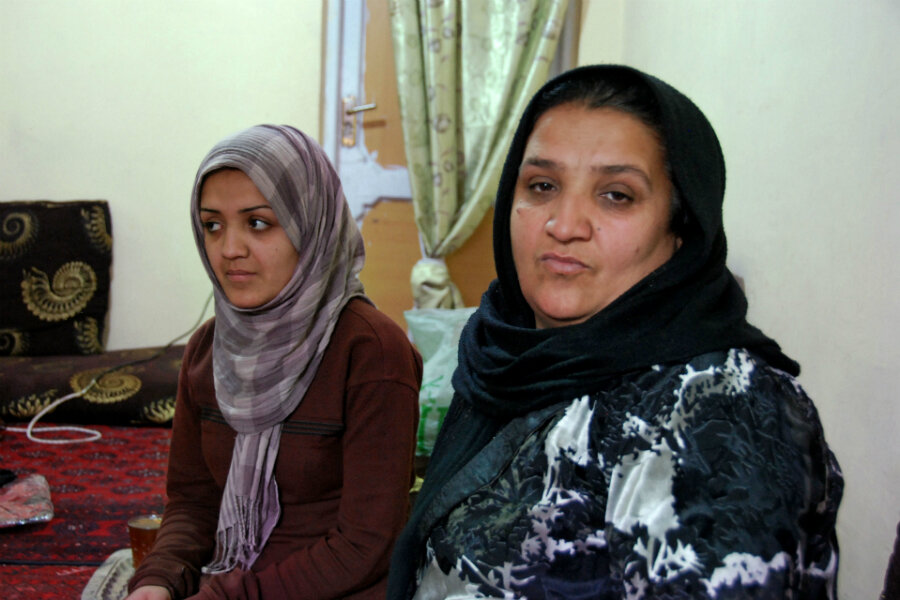In Afghan capital, schoolgirls embrace freedoms denied to their mothers
Loading...
| Kabul, Afghanistan
As a young girl Parween enjoyed school but was forced to drop out at age 13 when her family arranged her engagement. Parween says it was normal for rural Afghan girls to marry young, even though schools forced them to quit upon engagement.
“I was not very happy about it,” she says. “My family was liberal and the family I married into was conservative. Even if the school let me back, my new family would not have.”
Today, 30 years later, Parween’s life is unrecognizable to her 18-year-old daughter, Nabila. Like many of the current generation of Afghan urban girls, Nabila has embraced education and other freedoms. She is finishing high school, got engaged several days ago, and plans to continue her studies. Nabila’s fiancé, an engineer, comes from an educated family that supports her goal of becoming a doctor.
In 2001, when US-backed rebels ousted the Taliban government, less than a million Afghan children were enrolled in schools and almost none were girls. Today more than eight million Afghans are in school, and of those as many as three million are female. Although Afghanistan remains one of the most dangerous countries for women according to several international reports, the country has made steps forward, particularly for those living in urban areas.
The US and international organizations have funded many programs and initiatives designed to support Afghan women. Between 2011 and 2013 alone, the US spent $64.8 million on women’s projects.
“There was a dramatic development in the education in Afghanistan, not only for girls, but for everyone. Education is the main sector that has developed in Afghanistan,” says Kareema Salik, Kabul director at the Ministry of Women’s Affairs.
Such changes gave Nabila the kind of confidence needed to study medicine. “You have to be intelligent and talented to find a job as a female doctor, but I am not worried,” she says.
Rural-urban divide
Had Nabila grown up outside of Kabul, however, she likely would have had a radically different experience. In rural areas, insecurity and lawlessness make it difficult to monitor how many girls are attending school. Placing qualified female teachers in these areas is also a challenge.
Sima Samar, chairperson for the Afghanistan Independent Human Rights Commission, estimates that the country needs as many as 10,000 additional female teachers with bachelors degrees. Many areas also lack adequate schoolhouses. While Ms. Samar says it’s okay for families to send their young girls to outdoor classrooms, most families do not want their girls studying in public areas after they reach puberty.
“It is much, much better [today]," she says. "You cannot compare it to 2001. But when you really want to empower women and the female population, then primary education is not enough.”
Additionally, rural areas and even some of those in cities are still guided by cultural practices that hold back Afghan women. Although former President Hamid Karzai used an executive order to create a law in 2009 to help eliminate violence against women, it is rarely used and recent years have recorded an increase in violence against women.
Cultural barriers
Forced marriages are still common and as many as 12 percent of Afghan girls are pregnant or give birth between the ages of 15 and 19.
“The problem of women is not just the problem of war and conflict,” says Masooda Jalal, a prominent Afghan women’s rights activist and 2004 presidential contender. “It depends on centuries of negative traditional practices and cultural barriers that women have faced all their lives.”
Although there have been gains for Afghan women over the past decade, a report by the Special Inspector General for Afghanistan Reconstruction, which monitors US spending under a Congressional mandate, found that it’s unclear whether US aid played a direct role. And there are widespread concerns that these gains could be difficult to sustain.
Nabila shares these concerns, as the foreign presence recedes in Afghanistan. Looking to her mother, who now struggles to support the family by making window dressings from beads while her father and brothers are unemployed, Nabila remains committed to advancing as far as she is able.
“We are disappointed when we hear about my mother’s life. She could have studied more and made a career for herself,” she says.








